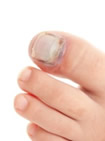Items filtered by date: May 2016
Treating Your Cracked Heels
 There are many different reasons as to why cracked heels may develop. Cracked heels can become irritated, painful, and itchy, often caused by dry skin, standing for long periods, medical conditions such as athlete’s foot, aging, and other factors. It’s important to treat your cracked heels so they don’t impact your walking or lead to further inflammation or infection. Consider using at-home treatments such as aloe vera, lemons, milk and honey, vinegar, foot ointments, and various oils to soothe your dry skin.
There are many different reasons as to why cracked heels may develop. Cracked heels can become irritated, painful, and itchy, often caused by dry skin, standing for long periods, medical conditions such as athlete’s foot, aging, and other factors. It’s important to treat your cracked heels so they don’t impact your walking or lead to further inflammation or infection. Consider using at-home treatments such as aloe vera, lemons, milk and honey, vinegar, foot ointments, and various oils to soothe your dry skin.
Cracked heels are unsightly and can cause further damage to your shoes and feet. If you have any concerns, consult with Dr. Michael E. Newman of Pennsylvania. Our doctor will assist you with all of your foot and ankle needs.
Cracked Heels
Cracked heels are unappealing, and make it harder for you walk around in sandals. Not only may they look bad, but they can also tear stockings, socks, and wear out your shoes. There are several methods to help restore a cracked heel and prevent further damage.
How do you get them?
Dry skin is the number one culprit in creating cracked heels. Many athletes, walkers, joggers, and even swimmers suffer from cracked heels. Age and skin oil production play a role to getting cracked heels as well.
Promote Healing
Over the counter medicines can help, especially for those that need instant relief, or who suffer from chronic dry feet.
Wear Socks – wearing socks with medicated creams, helps lock in moisture so it can stay on longer.
Moisturizers – applying it both day and night will help alleviate dryness which causes cracking.
Pumice Stones – these remove dead skin, and then you can massage cream onto your foot. This way the cream will be absorbed. The skin needs to be exfoliated; therefore the outer layer dead skin needs removal.
Change in Diet
Eating healthy, with a well-balanced diet, will give the skin a fresh and radiant look. Your body responds to what kinds of food you ingest. Omega-3 fatty acids and zinc supplements will also help with skin tissue.
Most importantly seek a health professional for foot care if something is wrong or doesn’t seem to be working. A podiatrist will help you with any questions or information needed.
If you have any questions please feel free to contact our offices located in Plymouth Meeting and Ambler, PA. We offer the newest diagnostic tools and technology to treat your foot and ankle needs.
Identifying Symptoms of Toenail Fungus
 Also known as onychomycosis, toenail fungus can be an unsightly infection that develops on your toenails, entering into the nail bed and nail plate. Characteristics of toenail fungus include your toenails becoming thick, lacking in shine, brittle, yellow, and separating from the skin. Treatment options for toenail fungus involve topical anti-fungal cream, oral anti-fungal prescription medicine, laser treatment, or surgery to remove the toenail.
Also known as onychomycosis, toenail fungus can be an unsightly infection that develops on your toenails, entering into the nail bed and nail plate. Characteristics of toenail fungus include your toenails becoming thick, lacking in shine, brittle, yellow, and separating from the skin. Treatment options for toenail fungus involve topical anti-fungal cream, oral anti-fungal prescription medicine, laser treatment, or surgery to remove the toenail.
While toenail fungus is troublesome to eradicate, doing so is not impossible. If you have any concerns with your feetconsult with Dr. Michael E. Newman of Pennsylvania. Our doctor will assist you with all of your foot and ankle needs.
Toenail Fungus Treatment
Toenail fungus is a problem which affects many people and is hard to get rid of. Fortunately, there are several methods to go about treating toenail fungus.
Antibiotics & Treatments
Lamisil – is the most commonly effective treatment for toenail fungus. It is available as an antibiotic Terbinafine tablet and cream. Terbinafine is a chemical component which kills fungal growth on the body. Applying regular doses will gradually kill the fungal growth. It is important to keep the area clean and air free.
Talcum powder – applying powder on the feet and shoes helps keep the feet free of moisture and sweat.
Sandals or open toed shoes – wearing these will allow air movement and help keep feet dry. They also expose your feet to light, which fungus cannot tolerate. Socks with moisture wicking material also help as well
Alternative Treatments
There are always surgical procedures that are available for toenail fungus. Some people would like immediate quick removal of toenail fungus. Surgeons will be able to cut through and remove the growth using laser surgery. It is important not to try and remove it yourself. Once removed, your old shoes will need to be replaced to avoid reinfection.
If you have any questions please feel free to contact our offices located in Plymouth Meeting and Ambler, PA. We offer the newest diagnostic tools and technology to treat your foot and ankle needs.
Kate Middleton May Have Hallux Limitus from Prolonged Wearing of High Heels
 Kate Middleton, Duchess of Cambridge, may possibly have hallux limitus, which was discovered when she revealed her bare feet at the Gandhi Smiriti Museum. Podiatrist Charlotte Wood noted that Kate may possibly have hallux rigidus, which can be caused by wearing high heels too much and which leads to pain, swelling, and stiffness. If not treated properly, hallux rigidus can progress into hallux limitus, which means the feet become extremely limited in movement, especially in the big toe joint.
Kate Middleton, Duchess of Cambridge, may possibly have hallux limitus, which was discovered when she revealed her bare feet at the Gandhi Smiriti Museum. Podiatrist Charlotte Wood noted that Kate may possibly have hallux rigidus, which can be caused by wearing high heels too much and which leads to pain, swelling, and stiffness. If not treated properly, hallux rigidus can progress into hallux limitus, which means the feet become extremely limited in movement, especially in the big toe joint.
Hallux limitus is a very uncomfortable condition to live with. If you have any concerns about hallux limitus, consult with Dr. Michael E. Newman of Pennsylvania. Our doctor will assist you with all of your foot and ankle needs.
What You Need To Know About Hallux Limitus
Hallux limitus is a medical condition which stands for “stiff toe.” This is an arthritic condition in which movement of the big toe is constrained. The pain is usually allocated between the large toe and foot. This condition is not of serious matter, but should be treated to avoid a hallux rigdus.
Symptoms
Toe pain is common, therefore many people tend to overlook this issue and believe it’s nothing serious. But, if you notice sharp pain, bone growths, tightness around the joint and even changes in the way you walk. It is vital to see a podiatrist before your condition worsens.
How Do I Get It?
Genetics – hallux limitus can be inherited from your parents, or someone can be who is born with a predisposition to arthritis as well.
Injury – overuse can cause trauma to the joints leading to extra bone growth and wear away the cartilage.
Treatment
X-rays are the most common used methods for diagnosis; it is also performed with a test to see the general function of the big toe.
Lifestyle & Physical Therapy – having motion and massages to the given area will help slow down complications and gradually increase flexibility.
R.I.C.E. – stands for rest, ice, compression and elevation. Combining the R.I.C.E method with other treatments is proven effective.
It is important that when one suffers any kind of foot injury, one should not over exert the toe with strenuous physical activity. Too much activity can destroy the cartilage, making the toe even stiffer.
If you have any questions please feel free to contact our offices located in Plymouth Meeting and Ambler, PA. We offer the newest diagnostic tools and technology to treat your foot and ankle needs.
Podiatrists Treat the Foundations of Our Bodies
 Foot bone and joint doctors, otherwise known as podiatrists, are knowledgeable in treating ailments of the ankles and feet. They also specialize in foot surgery and treat disorders and diseases. According to tnp.sg, “the feet and ankles have a complex connection of bones and strong ligaments that allow us to stand, pivot, twist, tiptoe, and push off.” This means that our feet and ankles are especially prone to injuries and wear and tear, so it’s important to get our feet checked out by a podiatrist regularly.
Foot bone and joint doctors, otherwise known as podiatrists, are knowledgeable in treating ailments of the ankles and feet. They also specialize in foot surgery and treat disorders and diseases. According to tnp.sg, “the feet and ankles have a complex connection of bones and strong ligaments that allow us to stand, pivot, twist, tiptoe, and push off.” This means that our feet and ankles are especially prone to injuries and wear and tear, so it’s important to get our feet checked out by a podiatrist regularly.
If you are experiencing pain in the feet or ankles, don’t join the stubborn majority refusing treatment. Feel free to consult with Dr. Michael E. Newman of Pennsylvania. Our doctor will assist you with all of your foot and ankle needs.
What is a Podiatrist?
Someone would seek care of a podiatrist when they have suffered a foot injury or have common foot ailments such as: heal spurs, bunions, arch problems, deformities, ingrown toenails, corns, foot and ankle problems etc.
Podiatric Treatment
A podiatrist will treat the problematic areas of the feet, ankle or lower leg by prescribing the following:
- physical therapy
- drugs
- perform surgery on lower extremity fractures
- orthotic inserts or soles
A common podiatric procedure a podiatrist will use is a scanner or force plate which will allow the podiatrist to know the designs of orthotics. Patients are then told to follow a series of tasks to complete the treatment. The computer will scan the foot a see which areas show weight distribution and pressure points. The podiatrist will read the analysis and then determine which treatment plans are available.
If you have any questions please feel free to contact our offices located in Plymouth Meeting and Ambler, PA. We offer the newest diagnostic tools and technology to treat your foot and ankle needs.
Obesity Associated with Diabetes is Bad News
 Diabetes, known as “a chronic disease affecting numerous organ systems,” including our feet, can both be caused and lead to various health issues. Obesity can also contribute greatly to diabetes, altering metabolism and further leading to “the deposition of carbohydrate products in the smallest arteries called arterioles.” Arterioles can block blood supply and result in various complications. Diabetics also suffer from peripheral neuropathy, which can make it hard to recognize any serious injuries or pain in the feet. It’s important to see a doctor to properly diagnose and address your condition.
Diabetes, known as “a chronic disease affecting numerous organ systems,” including our feet, can both be caused and lead to various health issues. Obesity can also contribute greatly to diabetes, altering metabolism and further leading to “the deposition of carbohydrate products in the smallest arteries called arterioles.” Arterioles can block blood supply and result in various complications. Diabetics also suffer from peripheral neuropathy, which can make it hard to recognize any serious injuries or pain in the feet. It’s important to see a doctor to properly diagnose and address your condition.
Diabetic foot care is important in preventing foot ailments such as ulcers. If you are seeking treatment, consult with Dr. Michael E. Newman of Pennsylvania. Our doctor will assist you with all of your foot and ankle needs.
Diabetic Foot Care
Diabetes affects millions of people every year. Diabetes can damage blood vessels in many parts of the body, including the feet. Because of this, taking care of your feet is essential if you have diabetes, and having a podiatrist help monitor your foot health is highly recommended.
The Importance of Caring for Your Feet
- Routinely inspect your feet for bruises or sores.
- Wear comfortable shoes that provide adequate support.
Patients with diabetes should have their doctor monitor their blood levels because blood sugar levels play such a huge role in diabetic care. Monitoring these levels on a regular basis is highly advised.
It is always best to inform your healthcare professional of any concerns you may have regarding your feet, especially for diabetic patients. Early treatment and routine foot examinations are keys to maintaining proper health, especially because severe complications can arise if proper treatment is not applied.
If you have any questions please feel free to contact our offices located in Plymouth Meeting and Ambler, PA. We offer the newest diagnostic tools and technology to treat your foot and ankle needs.
